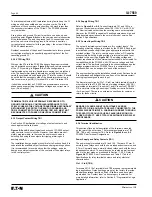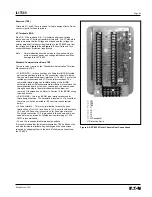
IL17569
Page 8-4
Effective June, 2001
NOTICE
AS SHOWN IN FIGURE 8.4, THE ANSI AND IEC “CURVE
SHAPES” ARE IN TERMS OF MULTIPLES OF I
PU
(PICKUP
CURRENT OF THE CT PRIMARY), WHEREAS, “SHORT DELAY”
AND “INSTANTANEOUS” ARE IN TERMS OF MULTIPLES OF
I
NOM
(5A OR 1A SECONDARY OF CT CURRENT). THE THERMAL
CURVE IS REPRESENTED IN TERMS OF MULTIPLES OF I
NOM
FOR ITS CURVE SHAPE, SHORT DELAY AND INSTANTANEOUS
SETTINGS. THIS MUST BE CONSIDERED IN THE COORDINA-
TION STUDY AND IN THE PROGRAMMING OF THE FP-5000
PROTECTIVE RELAY.
The ANSI curves are defined by ANSI C37.112, and IEC curves are
defined by lEC 255-3. These curve shapes combined with the
customized capability of the short delay and instantaneous
functions allow for very versatile coordinated protection schemes.
The thermal curve shape is also customized by the user for any
desired type of coordinated protection scheme.
These curves show how and when a particular relay will act for
given values of time and current. The more versatile the relay, the
easier it is to accomplish close coordination and achieve optimum
protection. Since the FP-5000 Protective Relay is very versatile, the
makeup of a typical curve is presented for clarification.
For the sake of simplification, the curve discussion will center on a
single line curve. Keep in mind, however, that a characteristic curve
in reality is represented by a band of minimum and maximum
values, not a line (
Figure
8-5
, Sample Electronic Trip Curves,
below). Minimum and maximum values are generally the result of
manufacturing tolerances for components and the relay’s accuracy.
Any expected value of tripping current or time could be the nominal
value anticipated within a plus or minus tolerance. The tolerances
are usually stated in terms of the relay’s accuracy and frequently
highlighted on the actual working curves. Accuracy is stated in
terms of a plus or minus percentage and represents a permitted
fluctuation on either side of the nominal tripping point for a family of
relays, like the FP-5000.
Figure 8-5. Sample Electronic Trip Curves
Adjustability
The adjustability of the relay permits movement of its characteristic
curve or parts of the curve. This movement can be done in both a
horizontal and vertical direction on the time current grid. The actual
shape of the curve can be changed along with the curve movement.
This adjustability permits distinct curves to be established to match
the electrical protection to the application. (
Figure 8-6
through
Figure 8-11.
) Horizontal movement of the ANSI and lEC curve
shapes is controlled by changing the pickup setting. Changing the
pickup setting of the thermal curves moves the point at which the
relay starts to time out along the curve shape.
Figure 8-6. Typical Inverse Time Overcurrent
Pickup Horizontal Movement
Summary of Contents for Cutler-Hammer FP-5000
Page 1: ...IL17569 Effective June 2001 Instructions for FP 5000 Protective Relay...
Page 7: ...IL17569 Table of Contents 6 Effective June 2001 This page left blank intentionally...
Page 13: ...IL17569 Page 2 2 Effective June 2001 Figure 2 2 FP 5000 Simple Wye Connected Application...
Page 14: ...Page 2 3 IL17569 Effective June 2001 Figure 2 3 FP 5000 Simple Open Delta Application...
Page 19: ...IL17569 Page 2 8 Effective June 2001 This page left blank intentionally...
Page 25: ...IL17569 Page 3 6 Effective June 2001 This page left blank intentionally...
Page 98: ...IL17569 Page 5 50 Effective June 2001 This page left blank intentionally...
Page 108: ...IL17569 Page 6 10 Effective June 2001 Figure 6 10 Common Ct Wiring Configurations...
Page 141: ...IL17569 Page 11 4 Effective June 2001 This page left blank intentionally...
Page 165: ...IL17569 Page Appendix 6 Effective June 2001 Figure 13 2 ANSI Very Inverse...
Page 166: ...Page Appendix 7 IL17569 Effective June 2001 Figure 13 3 ANSI Extremely Inverse...
Page 167: ...IL17569 Page Appendix 8 Effective June 2001 Figure 13 4 IEC A Figure 13 4 IEC A...
Page 168: ...Page Appendix 9 IL17569 Effective June 2001 Figure 13 5 IEC B...
Page 169: ...IL17569 Page Appendix 10 Effective June 2001 Figure 13 6 IEC C...
Page 170: ...Page Appendix 11 IL17569 Effective June 2001 Figure 13 7 IEC...
Page 171: ...IL17569 Page Appendix 12 Effective June 2001 Figure 13 8 ANSI...
Page 172: ...Page Appendix 13 IL17569 Effective June 2001 Figure 13 9 Thermal...
Page 173: ...IL17569 Page Appendix 14 Effective June 2001 Figure 13 10 Phase I4 t...
Page 174: ...Page Appendix 15 IL17569 Effective June 2001 Figure 13 11 Phase I2 t...
Page 175: ...IL17569 Page Appendix 16 Effective June 2001 Figure 13 12 Phase It...
Page 176: ...Page Appendix 17 IL17569 Effective June 2001 Figure 13 13 Phase 12 I4 t...
Page 177: ...IL17569 Page Appendix 18 Effective June 2001 Figure 13 14 Phase I2 t...
Page 178: ...Page Appendix 19 IL17569 Effective June 2001 Figure 13 15 Ground IT...
Page 180: ...Page Appendix 21 IL17569 Effective June 2001 This page left blank intentionally...
Page 187: ...Publication No IL17569 June 2001 Pittsburgh Pennsylvania U S A...
















































